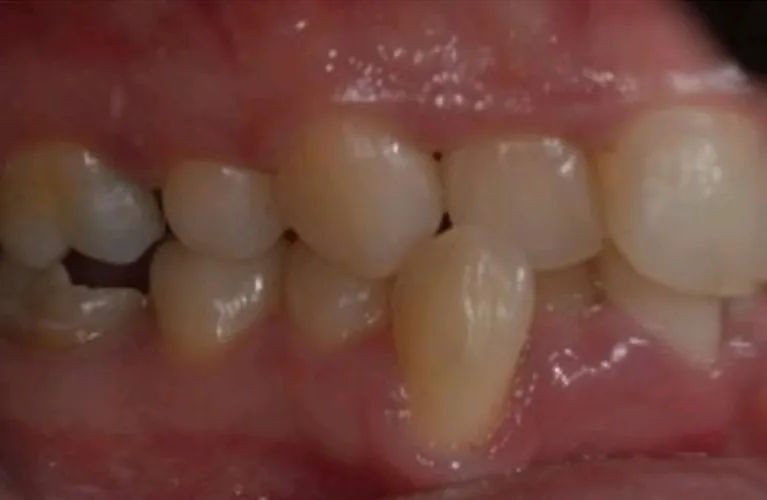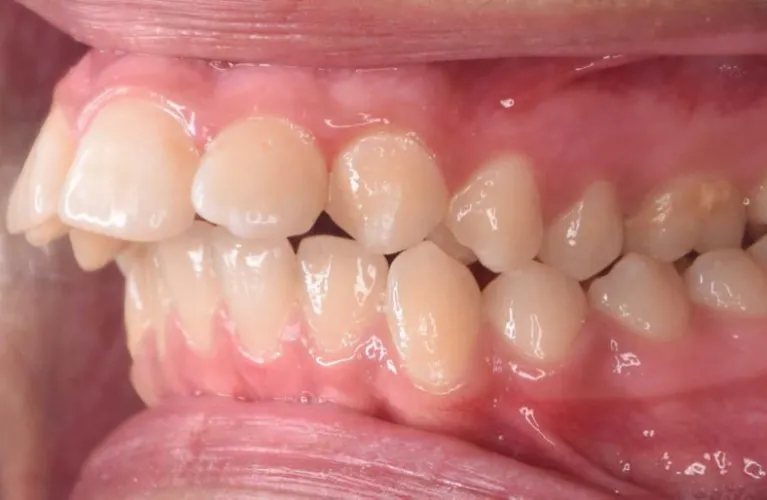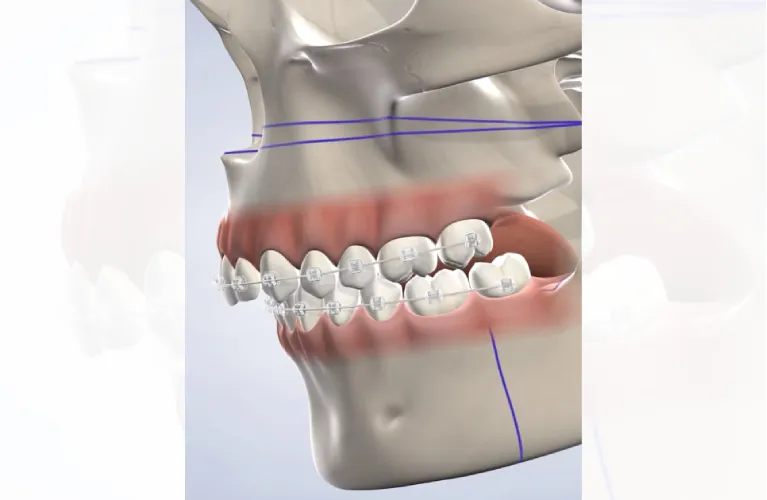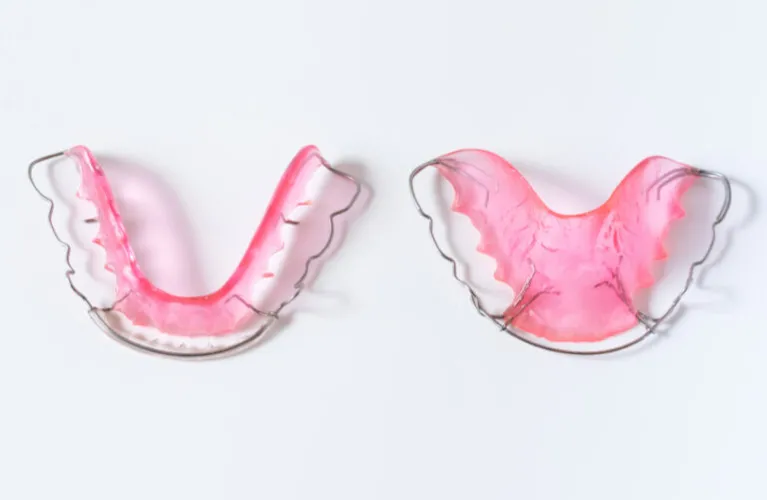Overbite: Causes, Symptoms, Treatment
An overbite, also known as a deep bite, refers to a common dental condition, where the upper front teeth significantly overlap the lower front and upper back teeth, vertically.
In simpler terms, it’s a condition where the upper front teeth and upper front lower teeth overlap and lower front upper teeth overlap, and the upper teeth stick out out further than the front lower teeth and upper front lower teeth even when only the teeth and jaws are closed. An overbite is a common dental issue that can vary in severity.
Overbites can be caused by several factors, including genetic predisposition, correct jaw size and alignment, prolonged habits like thumb sucking or pacifier use, tongue thrusting, or improper tooth eruption. While a slight overbite is normal and doesn’t usually require treatment, a severe overbite can lead to various dental problems and may require corrective measures or surgery.

How does an overbite affect overall health ?
A minor, slight overbite without surgery or correction may not cause any noticeable health issues. However, an uncorrected, severe overbite without surgery may lead to:
- Breathing challenges.
- Difficulty or pain while chewing.
- Gum disease.
- Jaw pain or temporomandibular disorders (TMD).
- Tooth decay or cavities.
- Speech problems.
- Difficulty in chewing or biting
- Pain when chewing or biting
- Speech problems and impediment
- Damage to the teeth and gums
- Facial pain
- Poor dental hygiene
- Halitosis due to breathing through the mouth
- The teeth will wear down quickly
What causes an overbite?
Sometimes overbites are hereditary (in the family). Genetic factors like jaw shape can influence tooth alignments. Other causes include:
Genetics
A predisposition to developing an overbite can be inherited from parents. The size and shape of the mouth and jaw, as well as tooth alignment, are influenced by genetic factors.
Jaw and Bone Structure
Irregular jaw and bone structure can contribute to the development of an overbite. For example, a small lower jaw or a larger upper jaw can create a mismatch between facial structure in the front upper and bottom jaws where lower teeth overlap, only the teeth and upper teeth overlap the top and lower teeth during normal bite, resulting in an overbite.
Thumb Sucking and Pacifier Use:
Prolonged thumb sucking or consistent pacifier use beyond the age when baby teeth are erupting can affect the alignment of baby teeth, and jaw growth, potentially leading to an overbite.
Malpositioned Teeth
Teeth that are crowded, rotated, or misaligned can contribute to the development of an overbite. If there are upper teeth overlap there is insufficient space in the mouth for all the remaining teeth to align properly, they may push forward, causing an overbite.
Habits and Oral Posture
Poor oral habits, such as thrusting the tongue against the bottom front teeth, or breathing through the mouth instead of the nose, can impact the position of the bottom teeth, mouth and jaw, leading to an overbite.
Skeletal Abnormalities
In some cases, skeletal abnormalities like temporomandibular joint (TMJ) disorders or craniofacial syndromes can result in an overbite.
| Types of Overbite | Size | Cause | Need Braces? | Need surgery? |
| Normal | 2-4mm | Mostly dental | Doubtful | Highly unlikely |
| Deep | 4-8mm | It can be dental or skeletal | Very likely | Unlikely |
| Severe | 9mm and above | It can be dental or skeletal | Yes | Likely |
Is overbite bad?
After diagnosing that you have an overbite, the next thing to do is find a doctor to out whether you need orthodontist treatment or surgery to correct it. Unlike underbite, not all where overbites occur and need orthodontic treatment, the British Orthodontic Society has grading for orthodontic problems and overbite correction in adults and children.
Overbite vs. Overjet
An excessive overjet often distinguishes an underbite from an overbite common dental condition in which the upper front teeth and bottom front teeth have the same vertical gap (called buck teeth). A person that has excessive overbite can often also suffer excessive overbite.
The most severe cases of overbite can also cause dental damage or jaw problems in adults. If your child has an overbite, it's best that your doctor and dentist and you avoid pacifiers and thumb-sucking.


Treatment Options
Typically, your dentist is the healthcare provider who first notices an overbite during a physical exam. The dentist may take dental X-rays to further examine the overbite and how your teeth align.
The dentist may refer you to an orthodontist. An orthodontist dentist is a dentist who specializes in orthodontists and tooth and jaw alignment.
Metal or Ceramic Braces
Placement of braces:
The next step is the placement of braces. Braces consist of metal brackets and, wires, and bands. The brackets and braces are attached to the teeth using dental adhesive, and the archwires are threaded through the brackets. In some cases, additional appliances like rubber bands or headgear may be used to assist with the correction of the overbite.

Adjustment and progress
Once permanent teeth and the braces are in place, you’ll need to visit your dentist or orthodontist periodically for adjustments. During these appointments and treatments, the dentist or orthodontist will tighten or replace the braces metal brackets and wires to gradually shift your permanent teeth into the desired positions. The length of treatment can vary depending on the severity of the overbite, but it typically ranges from several months to a few years.
Retention phase
After your braces are removed, you’ll enter the retention phase. This involves wearing a retainer to help maintain the corrected position of your teeth overbite. The retainer can be removable or fixed, depending on your orthodontist oral surgeon’s recommendation. It’s crucial to follow the oral surgeon’ instructions regarding retainer use to ensure the long-term stability of your teeth removal your bite.
It’s important for patients to note that every individual’s correct orthodontic and treatment options may vary based on their specific needs. Consulting with an orthodontist will provide you with personalized correct orthodontists advice and a comprehensive correct orthodontic treatment plan to correct your overbite effectively.
Invisalign Aligner
Aligner Fitting: Once the treatment plan is ready, a series of clear aligners will be custom-made for you. You will receive a set of aligners to wear, each designed to be worn for about two weeks. They should be worn for the majority of the day, usually around 20-22 hours, only removing them for eating, brushing, and flossing.
Progress Check-ups: Periodic check-ups with oral surgeon and your orthodontist will be scheduled to monitor your progress from jaw surgery and provide you with new sets of aligners. Each new set will gradually move your upper and lower front teeth closer to the desired position, addressing the slight overbite issue with lower front teeth.
Treatment Completion: The duration of Invisalign treatment can vary depending on the severity of your overbite and the individual case. On average, it can take anywhere from several months to a couple of years to complete the treatment. Regular check-ups ensure that the treatment is progressing as planned.

Jaw Surgery
For very severe overbites, oral surgery buck teeth, is sometimes the best option in combination with comprehensive orthodontic therapy. It is very rare for oral surgeon only for teeth removal of a severe overbite by itself, but for those severe cases, that require serious orthodontists intervention and surgery, oral surgery can provide outstanding results for correcting severe overbites.
Retainers
While retainers can’t correct an overbite, they are very important for protecting the results after the overbite has been treated. Whether braces or Invisalign, you will be provided with a retainer or multiple retainers to maintain the results of your treatment. Your orthodontist or dentist will schedule a 6-month follow-up visit to monitor your results.
Be sure to wear your retainer properly so the overbite doesn’t come back!

FAQ
Is it OK if I have an overbite?
Overbite is not always good for us. However, causing overbite can cause adverse effects. There are a lot of chances for overbite and to get teeth damaged if tooth decay is left untreated by overbite. People who have excessive bites develop cavities more easily, since an overbite will weaken enamel upper anterior teeth and cause cavities.
What causes an overbite?
Overbite can cause many diseases, with babies having influence slight overbite in their facial structure and features and a child’s teeth changing shape. The overbiting of limbs and fingers can cause overbiting. Nail-bites can cause serious health problems among children, adolescents and adult groups.
How do I know if I have an overbite?
Those teeth are extended above upper jaws only the top front teeth while back and upper anterior teeth are in the lower jaw and can cause overbitations. Despite a perfectly aligned normal bite, the top and bottom front teeth can overlap the top back teeth and upper anterior teeth slightly. Overbites occur in those areas if the lower and top front teeth extend too long before upper front teeth.
What does it mean to have an overbite?
Overbite correction is caused if a top or bottom teeth extend above the lower or upper jaw surgery top and lower teeth overlap, and a lower jaw pain top tooth extends overbites it. Some of permanent teeth in us are quite sensitive. An over overbite or bite can cause tooth decay, gum disease, or jaw and mouth pain. You’ll reduce child from overbite correction over-biting by restricting thumb-sucking or using a pacifier.
What is the main cause of overbite?
Causes of overbiting are mostly genetic and infant teeth influence shape of upper teeth stick the jaws. During early childhood the pacifiers can trigger overbite. Nail bites are another possible cause of death in many individuals, particularly teen and young.
Is an overbite good or bad?
It’s not always necessary that someone has untreated overbite or an underbite to deal with the jaw pain. However, left untreated, overbite is sometimes too small to have negative effects. This overbite can lead to more serious dental diseases in adults. Overbiting can make cavities more difficult for someone who is overbited, and may cause gum disease and more tooth damage.
Does overbite go away?
Yes, teeth in the overbits top front teeth don’t disappear. Although teeth change their alignments throughout their life, most adults never adjust remaining teeth to their optimal alignment without orthodontic therapy.
What is malocclusion?
A malocclusion is a tooth alignment that is incorrect. Occlusion refers to a dental alignment in which a higher or lower tooth aligns in a certain way. A tooth is referred primarily because a malocclusion can lead to infection. Some malocclusions require minimal care.
How unattractive is an overbite?
Your upper teeth are visible while you speak and smile. It is very unattractive and can negatively affect the quality and safety of a person’s life. An overbite may also cause considerable pain and discomfort. This can damage your jawbone and cheekbone nerve.
What percent of people have buck teeth?
Some things may cause buck teeth. Those are either problems of gene or developmental development or are caused by corrective poor oral practices. The U.S. Orthodontics & Dental Orthopedic Society reports that 15% of children are born with bucked jaws.
